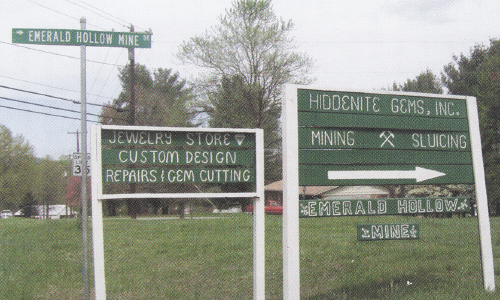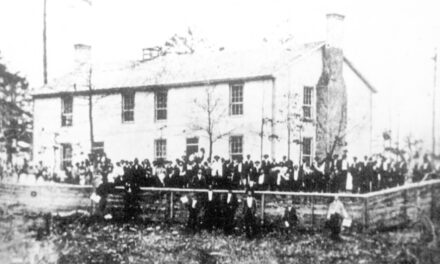
Ever imagine digging up a shovel of dirt to find an emerald, a chunk of gold, or a sapphire? As daydreamy as that might sound, people have been doing just that all over this area for hundreds of years. Along with the Shuford Gold Mine, down on the way to Sherrill’s Ford, the presence of hidden gems, in the ground over which you may have just walked, holds riches untold. The presence of precious minerals has always been a reason to dig western North Carolina in general and the Catawba Valley in particular.

If you wanna dig, history has proven Hiddenite is a good place to start. Look for the signs. Image courtesy of Jake Lowman.
As far back as 1800 people mined the ground around here for something that might dazzle the eye. Interest kicked into another gear in 1874 when a farmer found emeralds while turning up in the ground as he plowed his field. Five years later, geologist Willam Earl Hidden came looking for platinum. Thomas Edison sent Hidden here from Rhode Island to locate a suitable metal for conducting electricity. He didn’t find any. But what he ultimately stumbled across was even better.
W.E. Hidden chipped out of the earth a pale greenish rock that was identified as a variety of spodumene. Not everyone agreed. Opinions differed on exactly what it was. A number of the 19th century’s most learned minds argued that the semi-clear gem was unlike any other seen by humans before. They named it after the one who looked upon it first, calling it Hiddenite.
Soon, a community around where the find was first revealed sprang up in Alexander County. It too was called Hiddenite. Home to a number of mining operations, over sixty types of precious metals and gems have been dug up there, everything from amethyst to topaz. It seemed you really could plunge a shovel into western North Carolina ground and find something rare.
And lest you think that the mine had played out after its first wave, a 2006 discovery yielded an emerald ten-inches in length. That was on top of a 2003 emerald estimated as worth over $1 million, or a 1,438 carat emerald (discovered in 1969), the largest ever found in North America. One mine calculated the worth of all the precious gems that came out of their shafts. The total was more than $9 million. Not bad.
Over in Burke County, in the Bridgewater area, all kinds of minerals were rumored to exist, just waiting to be found. “My Budie and I” author Marcellus Thornton, (new book out soon) claimed that on his wife’s land, deposits of gold were abundant, as well as asbestos, considered a good thing at the time. He tried to entice real estate buyers by saying that an old man in the early 19th century prospected there and swore that gold had been ready and waiting. Unfortunately, the prospector went to his grave never divulging the secret of its pinpointed location. He left it for us to rediscover.
So, it seems that finding your fortune in the ground underneath you is not really a delusion at all. It’s historically based and happening all the time. Stake your claim.








